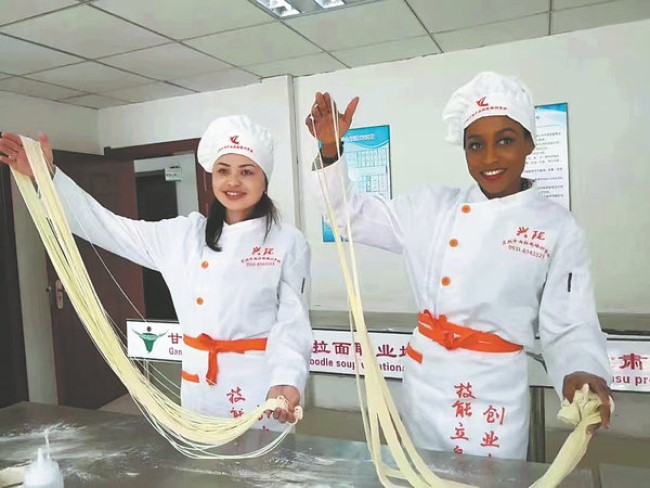National appetite for signature dish grows

Visitors from countries involved in the Belt and Road Initiative learn how to make Lanzhou beef noodles at a training school in Lanzhou, Gansu province. [Photo provided to China Daily]
Ma Baozi, an elderly man from the Hui ethnic group, started to popularize Lanzhou beef noodles in 1915. In June 2021, the craft of making the noodles was included in the fifth batch of representative projects of national intangible cultural heritage.
Ma Wenbin, a fourth-generation maker of Lanzhou beef noodles, has been working on the dish since the age of 18. He is the noodle chef at the renowned brand Jinding Beef Noodle in Lanzhou. For him, this bowl has become an essential part of life. He says the predecessor of beef noodles was called hot pot noodles.
The first known maker of the beef noodles, Ma Baozi, would process and cook the liver of beef and lamb to make a clear soup, which he would carry along with the cooked cold noodles in a basket with a pot on his shoulders and sell the food along the city streets.
"Before eating noodles, customers were served a bowl of hot soup, called the 'soup to clear', and if they liked the soup, they could stay and have the noodles," Ma Wenbin says.
He explains that in order to make the Lanzhou noodles, high-quality beef is carefully selected. The leg bone, after the meat is removed, is smashed to release the flavor.
The beef is cut into pieces before being soaked in water. It's important to note that the blood-soaked water should not be discarded. After simmering the meat and bones for four hours, they are removed, and the stock is then added to the beef broth. The soup is gently stirred with a ladle, and any foam on the surface is skimmed off to ensure that the liquid is clear. This method is known as "hanging the soup".
"A well-prepared soup is bright and clear, almost like a mirror or clearer than tap water. This is the hallmark of traditional clear-soup beef noodle," Ma Wenbin says, adding that a key ingredient to make the noodles firm and elastic is the well-kneaded dough, produced in the right texture after some work.
-
As AI encounters Dunhuang's art, the ancient caisson ceiling bridges centuries to the present.
View all stories

 Gansu thrives from green development
Gansu thrives from green development  >
>